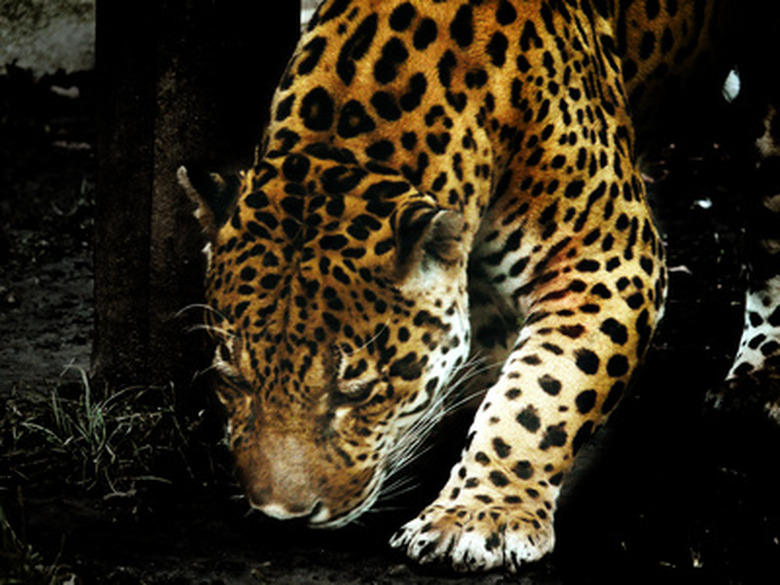Plants & Animals In Honduras
Honduras is the second-largest nation in Central America, stretching across the isthmus from the Caribbean to the Pacific. Despite aggressive deforestation, Honduras still maintains more forested area than most other countries in the region. Several types of forest dominate the landscape, including cloud forest, pine forest, rain forest and mangroves. Plant and animal species abound in the diverse forest ecosystems of Honduras, including species that have disappeared from the rest of the region. More than one Honduras wildlife refuge has been set aside to protect the diversity of life in the area.
Mammals In Honduras
Mammals In Honduras
More than 200 species of mammal are found in the forests of Honduras. Several rare creatures are included among the Honduras animals. Bats (Chiroptera) account for nearly half the mammals in the country with 98 known species occupying every forest ecosystem. The iconic jaguar (Panthera onca) is one of the rarest species in all of Central America. Most frequently seen in mangrove areas, jaguars are an endangered species in Honduras. West Indian manatees (Trichechus manatus), once common along the Caribbean coast of Honduras, are now rarely seen except in remote mangrove areas. Honduras' national animal, the white-tailed deer (Odocoileus virginianus), is the largest deer species in the country. Most often seen in the lowlands and pine forests, the white-tailed deer is a protected species. A wide variety of monkeys are also found in Honduras, including the white-headed capuchin (Cebus capucinus), Mexican spider monkey (Ateles geoffroyi vellerosus) and golden-mantled howler monkey (Alouatta palliata palliata).
An Abundance of Birds
An Abundance of Birds
Honduras has an exceptionally rich diversity of bird species. There are 18 parrot species, including the orange-chinned parakeet (Brotogeris jugularis), great green macaw (Ara ambigua), Pacific parakeet (Aratinga strenua) and the scarlet macaw (Ara macao), which is Honduras' national bird. Found in high-altitude tropical forests, the black-capped swallow (Notiochelidon pileata) is a migratory bird common in Honduras. The chestnut-mandibled toucan (Ramphastos swainsonii) is a frequent sight in the coastal lowland forests of Honduras. Known for their brightly colored face and exaggerated bill, they are sometimes kept as pets despite being a protected species.
Tropical Trees
Tropical Trees
Each forest ecosystem has a keystone species, meaning that one species defines the forest type. In Honduras, black mangrove (Avicennia germinans) and red mangrove (Rhizopora mangle) trees indicate the boundaries of the mangrove ecosystem. Mahogany (Swietenia macrophylla) trees are sometimes intermingled with mangrove species on dry land, indicating the beginning of the coastal lowland pine forests. Honduras pine (Pinus caribaea var. hondurensis) and ocote pine (Pinus oocarpa) are the only two species of pine in the country, although they dominate huge tracts of lowland forest. One of the most impressive trees in Honduras is the ceiba (Ceiba pentandra). Sometimes called kapok, it is a massive tree that can reach 250 feet in height with a 10-foot diameter trunk.
Flowering Plants
Flowering Plants
Honduras vegetation is very rich. Scientists estimate that there are more than 5,000 species of plants in Honduras. Flowering plants abound in most areas of the country, where they provide food for insect and bird species. One of the most prolific plant species in Honduras is sage (Salvia). Peach sage (Salvia dorisiana), Karwinski's sage (S. karwinskii) and blue vine sage (Salvia cacaliifolia) are all shrubby, perennial species that flourish in the cool, montane forests of central Honduras. Once a food source for indigenous people, yellow lotus (Nelumbo lutea) is one of the few flowering plants found in the mangrove forests. Known for its yellow cup-shaped flowers, it is often grown in water gardens as an ornamental plant.
References
- "A Field Guide to the Mammals of Central America and Southeast Mexico"; Fiona Reid; 2009
- "Coastal Plant Communities of Latin America"; Ulrich Seeliger; 1991
- "The Pines of Mexico and Central America"; Jesse P. Perry; 2009
- "Birds of Mexico and Central America"; Ber van Perlo; 2006
Cite This Article
MLA
Degnan, David. "Plants & Animals In Honduras" sciencing.com, https://www.sciencing.com/plants-animals-honduras-6787823/. 22 November 2019.
APA
Degnan, David. (2019, November 22). Plants & Animals In Honduras. sciencing.com. Retrieved from https://www.sciencing.com/plants-animals-honduras-6787823/
Chicago
Degnan, David. Plants & Animals In Honduras last modified March 24, 2022. https://www.sciencing.com/plants-animals-honduras-6787823/
